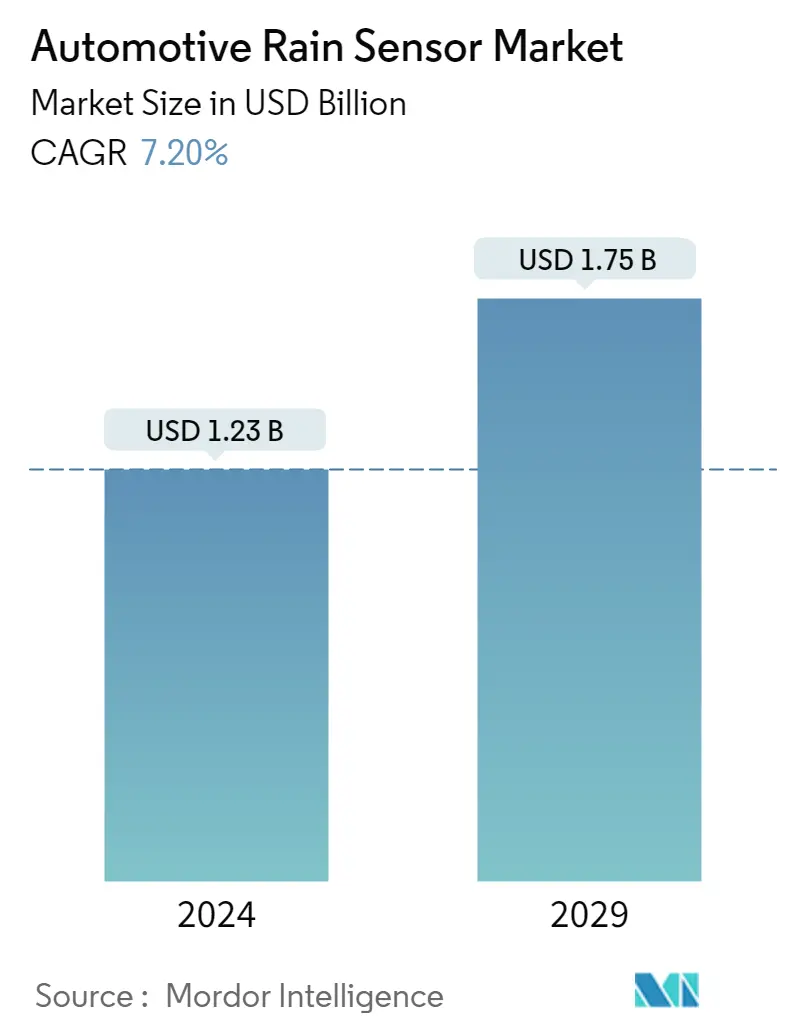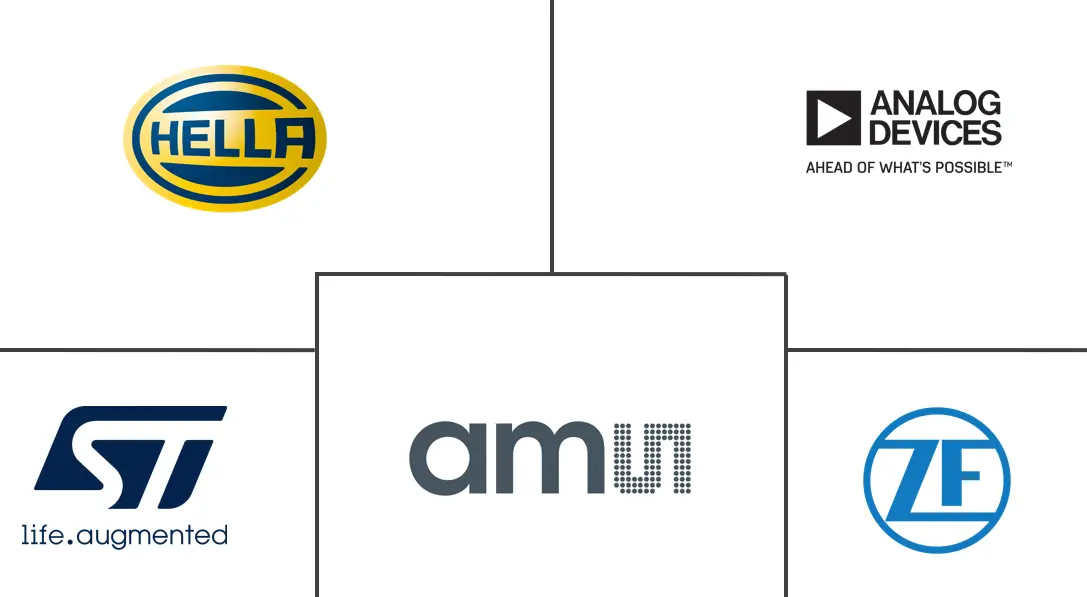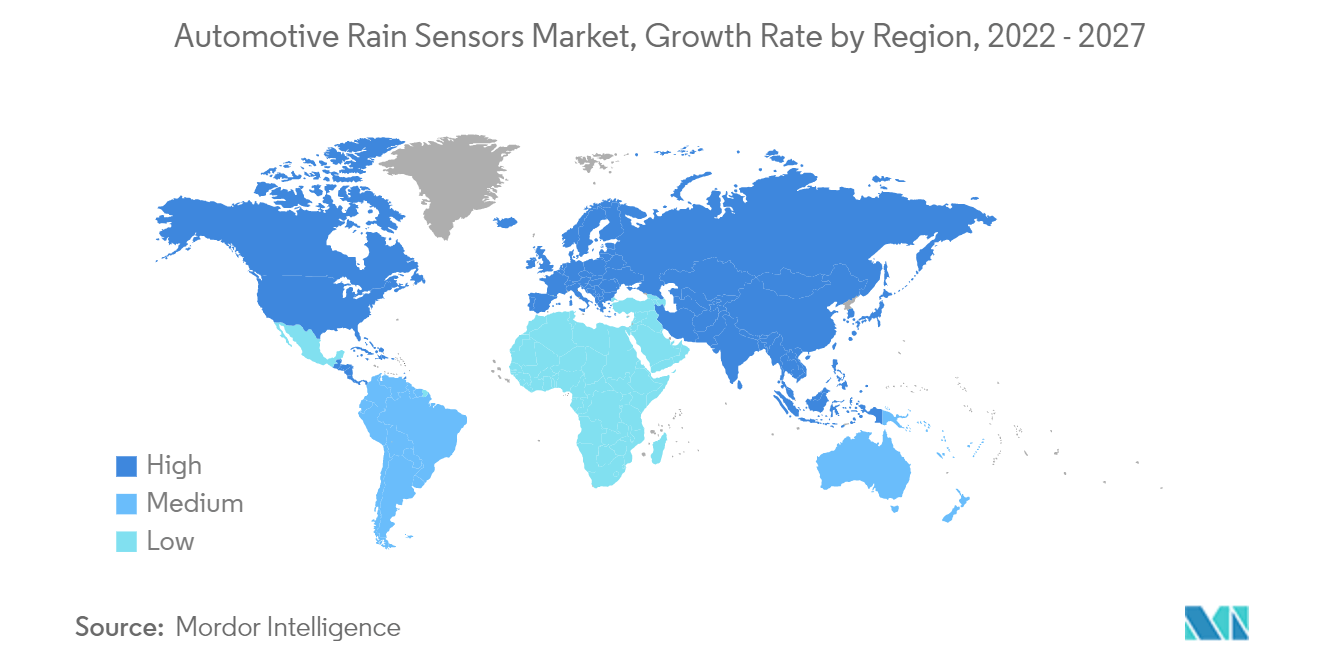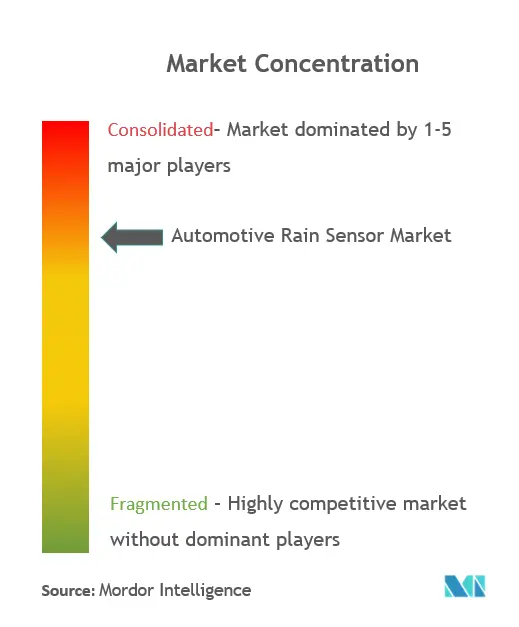Automotive Rain Sensors Market Size

| Study Period | 2019 - 2029 |
| Market Size (2024) | USD 1.23 Billion |
| Market Size (2029) | USD 1.75 Billion |
| CAGR (2024 - 2029) | 7.20 % |
| Fastest Growing Market | Asia-Pacific |
| Largest Market | Asia-Pacific |
Major Players
*Disclaimer: Major Players sorted in no particular order |
Automotive Rain Sensors Market Analysis
The Automotive Rain Sensor Market size is estimated at USD 1.23 billion in 2024, and is expected to reach USD 1.75 billion by 2029, growing at a CAGR of 7.20% during the forecast period (2024-2029).
The market was negatively affected by the COVID-19 pandemic in 2020 due to low-reported vehicle sales impacting the commercial potential for automotive rain sensors in the wake of a decline in vehicle production and supply chain disruptions. However, by the first half of 2021, the market had gained momentum as electric vehicle sales picked up across major regions globally.
The increasing use of electrical systems in cars and the expanding need for driver comfort and safety in vehicles, coupled with significant expansion of the automotive sector, are anticipated to act as major driving factors for market growth during the forecast period. In addition, the development of electric mobility and autonomous vehicle technology is expected to further contribute to the remarkable growth of the automotive rain sensors market. Moreover, improving economic conditions, increasing customer demand and interest, technical innovation, and stricter government restrictions are all favorable drivers for the market's expansion. Furthermore, leading luxury vehicle manufacturers are introducing electric variants of their vehicles in response to growing environmental concerns and rising fuel prices. It will also aid in the expansion of the sector. Due to the lower cost of automotive rain sensors, adopting such sensors in the economy and mid-range automobiles is expected to enhance market growth.
In general, several nations advise putting a rain sensor on cars because of excessive rain. However, there are some places where it might not even be necessary. The Middle East & North Africa are two places with very little rainfall. Some nations, such as Qatar, Saudi Arabia, the United Arab Emirates, Kuwait, and Egypt, have extremely low levels of precipitation, which lessens the need for automatic rain sensors. For example, rainfall is negligible in all seasons of the Middle East, as the region is nearly all desert. The only real winters in the Middle East happen in the mountainous regions of Saudi Arabia, where temperatures can reach freezing. Such typical climatic conditions discourage key OEMs from launching their models with such automatic rain-sensing technology features and hence are anticipated to limit the overall market development over the forecast period.
In most parts of North America, automatic wipers are already commonplace in vehicles and have advanced across most car segments. Rain sensors that manage the speed and frequency of wipers are not only a convenience feature, but they are also thought to make driving safer. In all weather situations, the proper wiper speed ensures optimal visibility. According to automakers, the rain sensor's location behind the rearview mirror is also perfect for a cluster of sensors, such as a camera, sun sensor, and ambient light sensor.
Automotive Rain Sensors Market Trends
RISING AWARENESS TOWARDS SAFETY AND COMFORT EXPECTED TO DRIVE DEMAND
The rain sensor is a driver assistance system that takes the strain off the driver by automatically activating the windshield wiper system when it rains, thereby significantly improving in-vehicle safety and comfort. Autonomous cars and connected vehicles are gaining consumers' interest and are anticipated to gain wider acceptance over the forecast period. The advanced driver assistance systems (ADAS) featured are expected to diminish the penetration gap between traditional cars and tomorrow's cars. For instance,
While some governments are focusing on mandating certain ADAS features across vehicles operating in their region, others are focusing on designing and implementing standards for ADAS features and their associated specifications to improve the vehicle's performance. For instance,
- Reflecting the increasing availability of advanced driver assistance systems (ADAS) on modern vehicles, the Chinese government has recently published three new standards that specifically cover advanced driver assistance systems. The first of these new standards is GB/T 39263-2020 on terms and definitions for advanced driver assistance systems (ADAS). The standard specifies definitions for various systems, which are split into two categories; information assistance systems and control assistance systems.
- By the end of 2022, all new cars on the EU market may have to be equipped with advanced safety systems. Following an agreement with the European Parliament in March 2021, the council adopted a regulation on the general safety of motor vehicles and the protection of vehicle occupants and vulnerable road users to reduce road casualties significantly. Additionally, Euro NCAP, a government-backed group that rates cars for safety, may require a driver-monitoring system to earn a five-star safety rating starting in 2023 or 2024.

ASIA-PACIFIC REGION IS EXPECTED TO HOLD THE HIGH MARKET SHARE IN THE AUTOMOTIVE RAIN SENSOR MARKET
During the forecast period, Asia-Pacific is expected to dominate with the highest CAGR. The economic growth of emerging countries such as China and India may increase the demand for passenger cars in the future; this is expected to induce global automobile manufacturers to invest heavily in technology and modern mass production systems, fueling the demand for automotive rain-sensing wiper systems. Moreover, increased investments in infrastructure development and industrialization that fuel the demand for commercial vehicles may also boost the market's growth prospects in this region. According to this market study report, APAC is expected to continue dominating the rain-sensing windshield wipers market throughout the forecast period. Countries like China, India, Indonesia, Japan, and South Korea will be the major market contributors. For instance,
- In March 2021, Skoda Auto India announced the launch of the all-new midsize SUV Kushaq, its first production car of four models, as part of the INDIA 2.0 project. The car features rain sensors that automatically switch on the low beam or windscreen wipers when required.
Europe is to be the fastest-growing region in the future. Germany leads this regional market due to the presence of major automakers in the country. Additionally, increased vehicle production and the adoption of advanced technologies may boost the market growth in this region. Furthermore, several favorable government initiatives implemented to revitalize the automobile industry, which was hit hard by COVID-19, are expected to drive market growth in these regions.
Additionally, the European region's higher production of luxury cars and high technological capabilities are key characteristics. Consumer's prefer high-performance vehicles, which is the major reason for the growth of the automotive rain sensor market.

Automotive Rain Sensors Industry Overview
The automotive rain sensors market is consolidated, with the presence of national and international players in the market. The major players follow strategies like product innovation, mergers, and acquisitions to expand their reach and hold their market position. The major players in the market are Denso Corporation, HELLA GmbH & Co. KGaA, ZF Friedrichshafen AG, Analog Devices Inc., Valeo group, ams-OSRAM International GmbH, etc.
- In March 2021, HELLA entered a collaboration with vehicle data provider Wejo. HELLA's comprehensive sensor expertise is expected to enable Wejo to identify new use cases for high-performance radar, battery, and rain-light-climate sensors.
Automotive Rain Sensors Market Leaders
-
HELLA GmbH & Co. KGaA
-
ams-OSRAM International GmbH
-
ZF Friedrichshafen AG
-
STMicroelectronics
-
Analog Devices Inc
*Disclaimer: Major Players sorted in no particular order

Automotive Rain Sensors Market News
- In March 2022, StradVision and ZF announced a partnership to expand their automated driving perception software portfolio. StradVision's SVNet software could enable vehicles to detect and identify objects even in adverse weather or low-light conditions, environmental sensor fusion for shuttles, and commercial and light vehicles that could be optimized for centralized electrical architectures.
- In July 2021, After the partnership with LiDAR expert AEye, Continental could integrate the long-range LiDAR technology into its full sensor stack solution to create the first full-stack automotive-grade system for Level 2+ up to Level 4 automated and autonomous driving applications. The solution based on AEye's LiDAR technology is a substantial part of the sensor setup for high-level automation systems.
Automotive Rain Sensors Market Report - Table of Contents
1. INTRODUCTION
- 1.1 Study Assumptions
- 1.2 Scope of the Study
2. RESEARCH METHODOLOGY
3. EXECUTIVE SUMMARY
4. MARKET DYNAMICS
- 4.1 Market Drivers
- 4.2 Market Restraints
-
4.3 Porter's Five Forces Analysis
- 4.3.1 Threat of New Entrants
- 4.3.2 Bargaining Power of Buyers/Consumers
- 4.3.3 Bargaining Power of Suppliers
- 4.3.4 Threat of Substitute Products
- 4.3.5 Intensity of Competitive Rivalry
5. MARKET SEGMENTATION
-
5.1 By Vehicle Type
- 5.1.1 Passenger Cars
- 5.1.2 Commercial Vehicles
-
5.2 By Geography
- 5.2.1 North America
- 5.2.1.1 United States
- 5.2.1.2 Canada
- 5.2.1.3 Mexico
- 5.2.1.4 Rest of North America
- 5.2.2 Europe
- 5.2.2.1 Germany
- 5.2.2.2 United Kingdom
- 5.2.2.3 France
- 5.2.2.4 Russia
- 5.2.2.5 Spain
- 5.2.2.6 Rest of Europe
- 5.2.3 Asia-Pacific
- 5.2.3.1 India
- 5.2.3.2 China
- 5.2.3.3 Japan
- 5.2.3.4 South Korea
- 5.2.3.5 Rest of Asia-Pacific
- 5.2.4 Rest of World
- 5.2.4.1 Brazil
- 5.2.4.2 Saudi Arabia
- 5.2.4.3 United Arab Emirates
- 5.2.4.4 South Africa
- 5.2.4.5 Rest of World
6. COMPETITIVE LANDSCAPE
- 6.1 Vendor Market Share
-
6.2 Company Profiles
- 6.2.1 HELLA GmbH & Co. KGaA
- 6.2.2 Denso Corporation
- 6.2.3 ZF Friedrichshafen AG
- 6.2.4 Analog Devices Inc
- 6.2.5 STMicroelectronics
- 6.2.6 Valeo group
- 6.2.7 Semiconductor Components Industries LLC
- 6.2.8 ams-OSRAM International GmbH
- 6.2.9 HAMAMATSU PHOTONICS KK
- *List Not Exhaustive
7. MARKET OPPORTUNITIES AND FUTURE TRENDS
** Subject To AvailablityAutomotive Rain Sensors Industry Segmentation
The rain sensor device in an automotive vehicle detects rain on the windshield. The sensor detects water on the windshield using a control module with an LED. When the glass becomes wet, less light enters the sensor. When the amount of light reflected onto the sensor reaches a certain threshold, the software in a rain-sensing system activates the wipers. Furthermore, the speed and duration of wiper activation depend on the windscreen wetness ratio and are controlled by these sensor modules.
The automotive rain sensors market has been segmented by vehicle type and geography.
By vehicle type, the market has been segmented into passenger cars and commercial vehicles. By geography, the market has been segmented into North America, Europe, Asia-Pacific, and the Rest of the world.
The report also covers the market size and forecast for the automotive rain sensors market across the regions mentioned. For each segment, the market sizing has been done in terms of value (USD billion).
| By Vehicle Type | Passenger Cars | |
| Commercial Vehicles | ||
| By Geography | North America | United States |
| Canada | ||
| Mexico | ||
| Rest of North America | ||
| By Geography | Europe | Germany |
| United Kingdom | ||
| France | ||
| Russia | ||
| Spain | ||
| Rest of Europe | ||
| By Geography | Asia-Pacific | India |
| China | ||
| Japan | ||
| South Korea | ||
| Rest of Asia-Pacific | ||
| By Geography | Rest of World | Brazil |
| Saudi Arabia | ||
| United Arab Emirates | ||
| South Africa | ||
| Rest of World |
Automotive Rain Sensors Market Research FAQs
How big is the Automotive Rain Sensor Market?
The Automotive Rain Sensor Market size is expected to reach USD 1.23 billion in 2024 and grow at a CAGR of 7.20% to reach USD 1.75 billion by 2029.
What is the current Automotive Rain Sensor Market size?
In 2024, the Automotive Rain Sensor Market size is expected to reach USD 1.23 billion.
Who are the key players in Automotive Rain Sensor Market?
HELLA GmbH & Co. KGaA, ams-OSRAM International GmbH, ZF Friedrichshafen AG , STMicroelectronics and Analog Devices Inc are the major companies operating in the Automotive Rain Sensor Market.
Which is the fastest growing region in Automotive Rain Sensor Market?
Asia-Pacific is estimated to grow at the highest CAGR over the forecast period (2024-2029).
Which region has the biggest share in Automotive Rain Sensor Market?
In 2024, the Asia-Pacific accounts for the largest market share in Automotive Rain Sensor Market.
What years does this Automotive Rain Sensor Market cover, and what was the market size in 2023?
In 2023, the Automotive Rain Sensor Market size was estimated at USD 1.15 billion. The report covers the Automotive Rain Sensor Market historical market size for years: 2019, 2020, 2021, 2022 and 2023. The report also forecasts the Automotive Rain Sensor Market size for years: 2024, 2025, 2026, 2027, 2028 and 2029.
Automotive Rain Sensors Industry Report
Statistics for the 2024 Automotive Rain Sensors market share, size and revenue growth rate, created by Mordor Intelligence™ Industry Reports. Automotive Rain Sensors analysis includes a market forecast outlook to 2029 and historical overview. Get a sample of this industry analysis as a free report PDF download.



